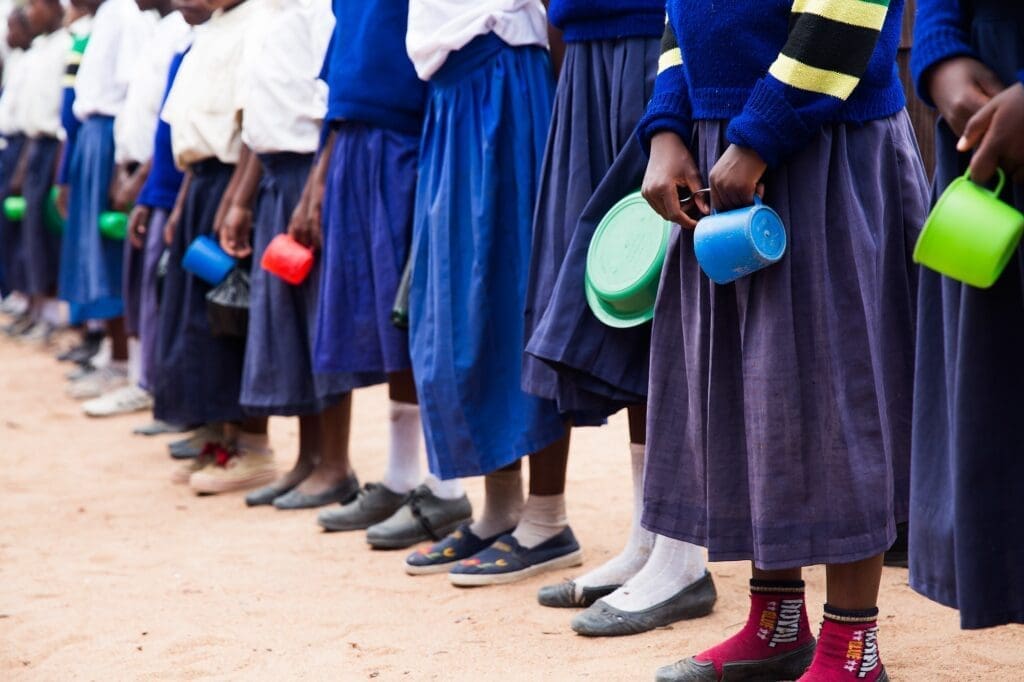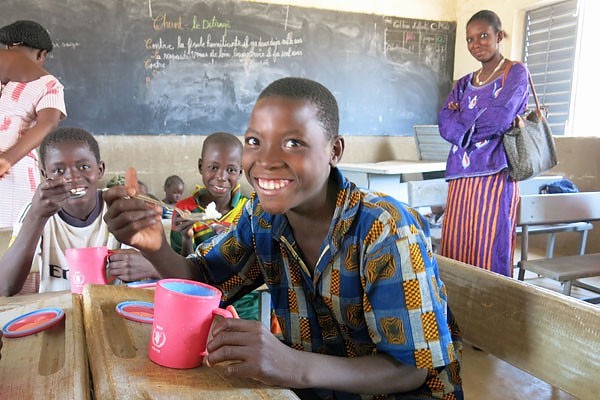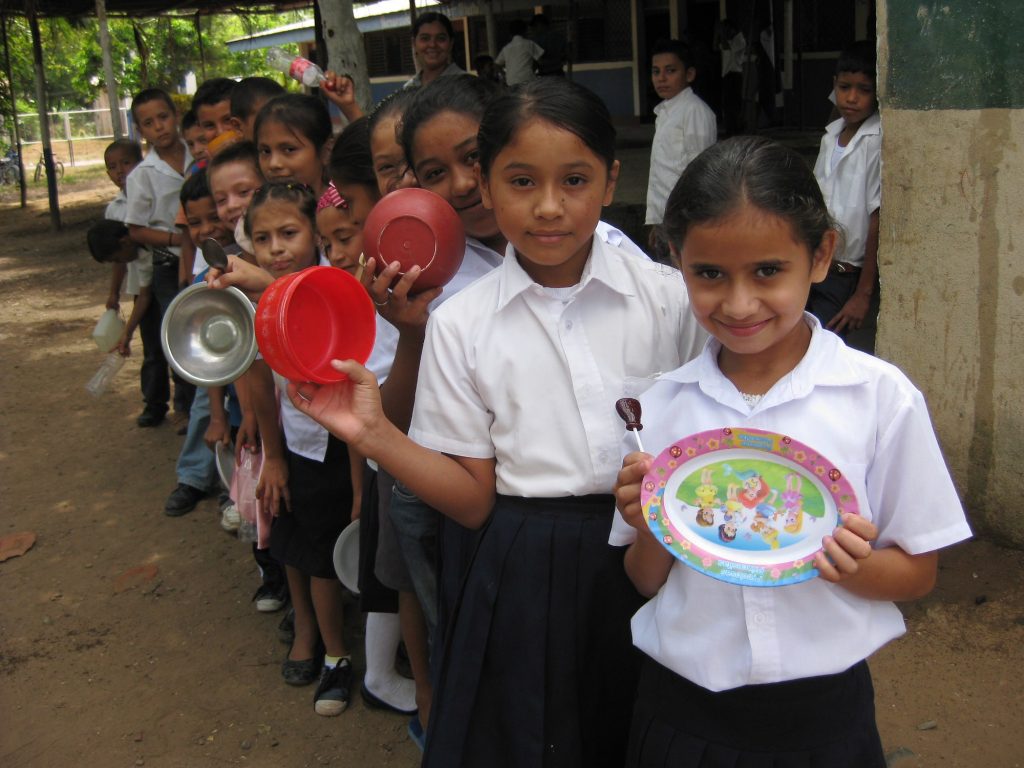Around The World In 80,000 Schools

Every day, some 66 million boys and girls across the globe are unable to attend school. Instead, chronic poverty forces their parents to keep them out of the classroom so they can work or take care of the family.
As the world’s largest provider of school meals, the U.N. World Food Programme (WFP) is helping children in impoverished countries return to and remain in the classroom — simply by delivering good nutrition.
In 2014, WFP supplied nourishing meals to 18.2 million boys and girls in thousands of schools across the planet.
75,500 schools worldwide, in fact.

WFP/Aboubacar Guindo
By distributing school meals to children in need and easing the burden of putting food on the table, WFP is removing hunger as a barrier to education.
Studies have shown that school meals can boost attendance, enrollment and graduation rates in low-income communities — especially for girls who would otherwise be married young, sent off to work or forced to stay at home and care for the household.
School meals also help children concentrate in the classroom, making it easier to learn and succeed.
“I’m a good example of what school meals can achieve,” says Dr. Mamphono Khaketla, Lesotho’s Minister of Education. Khaketla received school meals from WFP as a child and credits the agency’s support for propelling her into a career dedicated to education and child nutrition in her country.
In 2014, WFP distributed nearly 700 million pounds of food to students in 65 countries.

School meals provide a safety net for families in crisis
During emergencies, WFP’s school meals also act as crucial safety nets. This year, the U.N. agency has already scaled-up school-feeding programs in more than 38 countries in response to armed conflict, natural disaster and financial or political crises.
These countries include Burundi, the Central African Republic, Sudan and Syria, where millions have families have been plunged into hunger.
In Liberia, WFP is supporting more than 127,000 students in communities across the country that are still recovering from last year’s devastating Ebola outbreak.

WFP/Rein Skullerud
For especially vulnerable children — like orphans, the disabled, former child soldiers and those affected by HIV/AIDS — school meals from WFP offer a reliable source of food and a powerful incentive to stay in school.
In the Central African Republic (CAR), WFP is delivering food assistance to orphans like 7-year-old Dieu-Merci, above, who lost both of her parents to the country’s ongoing conflict.
WFP feeds students in 75,500 schools across the planet
Through a new partnership with UNICEF, the agency is also distributing de-worming tablets to students like Dieu-Merci to protect against common infections that prevent the body from properly absorbing nutrients.
“After each meal I feel stronger!” says Korka, a 2nd grader at the Bankass school in Kani Kombole, Mali. Korka is the first member of her family to attend school. She wants to be a nurse when she grows up.

School meals have the power to lift entire families out of poverty
WFP’s school meals aren’t just helping hungry children either. In especially poor communities, the agency gives take-home rations to students so entire families can receive food assistance in exchange for regular school attendance.
In Afghanistan, for example, WFP distributes high-energy biscuits to students along with containers of fortified vegetable oil for their families.
The agency is also working to improve sanitation and hygiene practices. It’s not uncommon for a child in rural Afghanistan to carry as many as 1,000 hookworms, roundworms or whipworms, which deplete blood and nutrients and weaken the body’s ability to absorb certain carbohydrates, proteins and vitamins like Vitamin A.
“Our students are healthier now that they receive hygiene-related lessons such as hand-washing before lunch,” explains the director of the Namontana Primary Public School in Madagascar, where WFP offers teacher training and nutrition curricula in addition to supplying school meals.
![]()
WFP/Rein Skullerud
![]()
WFP/Rein Skullerud
“Homegrown” school meals nourish hungry children and support local agriculture
Small-scale farmers can also benefit from WFP’s school meals program. Whenever possible, the agency sources its meals using locally grown crops. This homegrown approach provides vital nutrition to growing bodies and minds, as well as a reliable market for struggling farmers.
Right now, the U.N. agency is piloting home-grown school feeding in 32 countries across the globe.
These countries include: Armenia, Bangladesh, Bolivia, Burkina Faso, Burundi, Cambodia, Cote d’Ivoire, Ethiopia, The Gambia, Ghana, Guinea — Bissau, Haiti, Honduras, Indonesia, Kenya, Lao PDR, Liberia, Malawi, Mozambique, Nicaragua, Niger, Pakistan, Rwanda, Sao Tome and Principe, Senegal, Tanzania and Zambia.

WFP/Celestine Ouedraogo
Earlier this year, WFP introduced locally produced yogurt into its school feeding program in Burkina Faso, increasing students’ dietary diversity while creating a stable market for local dairy farmers.

WFP sponsors classroom education on smart nutrition and dietary diversity
Thanks in part to WFP’s support, students at Yurung Lower Secondary School in Bhutan, above, are learning how to grow their own vegetables as part of a new curriculum. What began as a school garden has blossomed into a community garden where parents and members of a local cooperative can harvest their own produce.
“I think we still have a choice to make this world of ours better,” says Dungkar Drupka, a WFP staffer who received school meals as a child growing up in Bhutan in the early 1970s.
“I continue to remain inspired by WFP — not by what it is, but by what it is doing, meaningfully. Many of my contemporaries from this poor but happy nation will tell a very similar story — WFP gave us opportunities that otherwise we would never have known.”

WFP/Julissa Aguilar
Just 25¢ can fill a child’s cup with healthy porridge, rice or beans from WFP
School meals are one of the smartest and most affordable investments the world can make to break the cycle of poverty and hunger. WFP estimates that every dollar spent on school meals yields $3 to $8 in economic returns as a result of improved productivity and overall health.

WFP/Deepesh Shrestha
Over the past 45 years, 38 countries have taken over WFP’s school meal programs
In 2013, El Salvador became the latest country to take control of its school meals program from WFP. The U.N. agency’s ultimate goal is to hand over control of all of its school meals programs to governments once they have the funding, framework and capacity in place.

WFP/Anne Poulsen
Since the launch of WFP’s first school meals program nearly 50 years ago, the agency has transformed millions of lives and fueled the success of an Olympic runner in Kenya, a record-breaking mountain climber in Nepal, a budding scientist in Rwanda and a national journalist in Burundi, among others.
The equation is simple:
Education + School Meals = Zero Hunger




